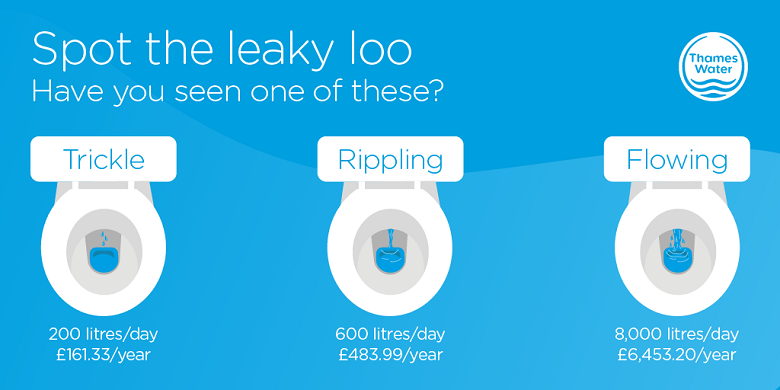Identifying leaks
When you find a leak, it's important to fix it fast. The longer you leave a leak, the more damage it can cause to your property and our water supply.
If you're on a water meter, leaks can increase your bill too.
Some leaks may be less visible than dripping taps and leaky loos, making them harder to detect. Here are some common signs and ways to check for leaks at home.
Common signs of a leak
- Wet or damp patches in the garden during dry weather
- Dirt or air in your water
- Cracks in paving
- Potholes or sinkholes appearing
- A noticeable reduction in water pressure
- An unexpected increase in usage (if you're on a meter)
If you have a water meter
- Make sure all your water appliances are turned off
- Turn off your inside stop valve (this is usually under your sink)
- Take a meter reading and write it down
- Wait 30 minutes then take another meter reading
- If the two readings are the same, you don't have a leak. If they're different, you have a leak somewhere between the meter and the inside stop valve
Leaky loos
A leaky loo can waste an average of around 400 litres of water a day. That's equal to five full bathtubs.
A leak in your toilet will look like water trickling, rippling or flowing at the back of the bowl. Even a small trickle of water can waste up to 200 litres of water per day and cost an extra £161.33 per year.
Rippling water is likely to waste 600 litres a day and cost £483.99 per year.
If you can see water flowing constantly, this could waste 8,000 litres per day and cost £6,453.20 per year.

Leaky toilet guide
Our step-by-step guide shows you how to check for leaks, confirm what the problem is and get it fixed.
Test for leaks
It's easy to check if your toilet has a leak, just follow these steps.
- Wait for 30 minutes after flushing then dry the back of the pan with toilet paper
- Place a new, dry sheet of toilet paper on the back of the pan
- Leave it there for at least three hours (overnight is best) without using the toilet
- If the paper is wet or torn, you have a leaky loo
Leaky loos are usually caused by a faulty flush valve or fill valve inside your tank.
Find the problem
Flush valve
Mark the water level inside your tank and check it 10 minutes later. If the water level has dropped, you’ll know the problem is your flush valve.
Fill valve
If you can, check if any water is running into the overflow tube inside your toilet tank. If your tank takes a long time to refill or your flush isn’t as powerful as normal, your fill valve isn’t working properly.
Repair the leak
You'll need to arrange repair within four weeks of finding the leak. You can fix the leak yourself, or hire a plumber. We recommend using a WaterSafe approved plumber.
For peace of mind and 24/7 access to emergency plumbing services, check out our home plumbing and drainage cover.
If the leak isn't repaired within four weeks, we may need to step in to protect our water supply. View our leakage code of practice.
WhatsApp us
Message us on WhatsApp, so you can get on with your day and respond at your pace. We're available 24/7.